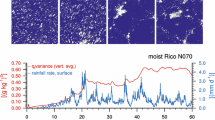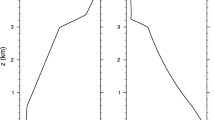Abstract
A new equilibrium model for shallow-cumulus-topped mixed layers is presented. A variant on the w * closure for the shallow-cumulus mass flux is applied that retains the convective area-fraction in its formulation. As opposed to being constant, the fraction is explicitly modeled using a statistical closure as a function of the saturation deficit and humidity variance at cloud base. As a consequence, important new interactions are introduced between the convective transport, humidity, and depth of the mixed layer. This mechanism, which we call the mass-flux humidity feedback, helps determine the character of the equilibrium state such that the mixed-layer top is maintained close to the cloud-base height. Due to the strong sensitivity of the mass flux to the area fraction, the latter thus acts as a regulator or valve mechanism on moist convective transport. As a consequence, the mixed-layer model is able to explain the robustness of many aspects of the shallow-cumulus boundary layer that is typically found in observations and large-eddy simulations (LESs). The model is evaluated for a single-LES case as well as for global climatology obtained from a 40-year reanalysis of meteorological data by the European Centre for Medium-range Weather Forecasts (ECMWF). LES characteristics of convective mass flux, cloud fraction, humidity variance, cloud-base height, and surface fluxes of heat and humidity are reproduced. The solution on reanalysis fields reproduces the spatial structure of mixed-layer temperature and humidity and their associated surface fluxes in the subtropical Atlantic and Pacific trade wind regions. Furthermore, the spatial structure of the convective area-fraction matches that of synoptic surface observations of frequency of occurrence of shallow cumulus. Particularly striking is the smooth onset of the convective area-fraction and mass flux along the trade-wind trajectory that is reproduced, from zero to typical trade-wind values. The cumulus onset represents the necessity for shallow-cumulus mass flux to occur in order to close the mixed-layer budgets of heat, moisture, and mass, as a response to the changing magnitude of large-scale subsidence and free tropospheric humidity along the trajectory. Finally, the mass flux model is implemented in an intermediate-complexity tropical climate model to study its behavior when fully interactive with the larger-scale flow. A climate run then shows that the model is stable, due to the mass-flux humidity feedback acting to keep the shallow-cumulus boundary layer close to its equilibrium state for long, climatological timescales.
Similar content being viewed by others
References
Albrecht B.A., Betts A.K., Schubert W.H., Cox S.K. (1979): A model of the thermodynamic structure of the Trade-wind boundary layer. Part I: Theoretical formulation and sensitivity tests. J. Atmos. Sci. 36, 73–89
Albrecht B.A., Bretherton C.S., Johnson D., Schubert W.H., Frisch A.S. (1995): The Atlantic stratocumulus transition experiment—ASTEX. Bull. Am. Meteorol. Soc. 76, 889–904
Anthes R.A., Keyser D. (1979): Tests of a fine-mesh model over Europe and the United States. Mon. Wea. Rev. 107, 963–984
Augstein E., Riehl H., Ostapoff F., Wagner V. (1973): Mass and energy transports in an undisturbed Atlantic trade-wind flow. Mon. Wea. Rev. 101, 101–111
Augstein E., Schmidt H., Wagner V. (1974): The vertical structure of the atmospheric planetary boundary layer in undisturbed Trade winds over the Atlantic Ocean. Bound. Layer Meteorol. 6, 129–150
Berg L.K., Stull R.B. (2004): Parameterization of joint frequency distributions of potential temperature and water vapor mixing ratio in the daytime convective boundary layer. J. Atmos. Sci. 61, 813–828
Betts A.K. (1973): Non-precipitating cumulus convection and its parameterization. Q. J. R. Meteorol. Soc. 99, 178–196
Betts A.K. (1976): Modeling subcloud layer structure and interaction with a shallow cumulus layer. J. Atmos. Sci. 33, 2363–2382
Betts A.K., Ridgway W. (1989): Climatic equilibrium of the atmospheric convective boundary layer over the tropical ocean. J. Atmos. Sci. 46, 2621–2641
Bretherton C.S., Wyant M.C. (1997): Moisture transport, lower-tropospheric stability, and decoupling of cloud-topped boundary layers. J. Atmos. Sci. 54, 148–167
Bretherton C.S., McCaa J.R., Grenier H. (2004): A new parameterization for shallow cumulus convection and its application to marine subtropical cloud-topped boundary layers. Part I: description and 1D results. Mon. Wea. Rev. 132, 864–882
Brown A.R., Chlond A., Golaz C., Khairoutdinov M., Lewellen D.C., Lock A.P., MacVean M.K. Moeng C-H., Neggers R.A.J., Siebesma A.P., Stevens B. (2002): Large-eddy simulation of the diurnal cycle of shallow cumulus convection over land. Q. J. R. Meteorol. Soc. 128, 1075–1094
Cheinet S. (2004): A multiple mass flux parameterization for the surface-generated convection. Part II: Cloudy cores. J. Atmos. Sci. 61, 1093–1113
Cuijpers H., Duynkerke P.G. (1993): Large-eddy simulation of trade-wind cumulus clouds. J. Atmos. Sci. 50, 3894–3908
Cuijpers H., Bechtold P. (1995): A simple parameterization of cloud water related variables for use in boundary layer models. J. Atmos. Sci. 52, 2486–2490
Deardorff J.W. (1970): Convective velocity and temperature scales for the unstable planetary boundary layer and for Rayleigh convection. J. Atmos. Sci. 27, 1211–1212
Garratt J.R. (1977): Review of drag coefficients over oceans and continents. Mon. Wea. Rev. 105, 915–929
Grant A.L.M. (2001): Cloud-base fluxes in the cumulus-capped boundary layer. Q. J. Roy. Meteorol. Soc. 127, 407–422
Grant A.L.M., Brown A.R. (1999): A similarity hypothesis for shallow-cumulus transports. Q. J. R. Meteorol. Soc. 125, 1913–1936
Holland J.Z., Rasmusson E.M. (1973): Measurement of atmospheric mass, energy and momentum budgets over a 500-kilometer square of tropical ocean. Mon. Wea. Rev. 101, 44–55
Lenderink G., Siebesma P., Cheinet S., Irons S., Jones C.G., Marquet P., Müller F., Olmeda D., Calvo J., Sanchez E., Soares P.M.M. (2004): The diurnal cycle of shallow cumulus clouds over land: a single column model intercomparison study. Q. J. R. Meteorol. Soc. 130, 3339–3364
Lilly D.K. (1968): Models of cloud-topped mixed layers under a strong inversion. Q. J. R. Meteorol. Soc. 84, 292–309
Neelin J.D., Zeng N. (2000): A quasi-equilibrium tropical circulation model–formulation. J. Atmos. Sci. 57, 1741–1766
Neggers R.A.J., Siebesma A.P., Lenderink G., Holtslag A.A.M. (2004): An evaluation of mass flux closures for diurnal cycles of shallow cumulus. Mon. Wea. Rev. 132, 2525–2538
Neggers, R.A.J., Stevens, B., Neelin, J.D.: Variance scaling in shallow cumulus topped mixed layers. Q. J. R. Meteorol. Soc. August 2006 (submitted)
Neggers, R.A.J., Neelin, J.D., Stevens, B.: Impact mechanisms of shallow cumulus convection on tropical climate dynamics. J. Clim. July 2006 (accepted pending minor revisions)
Nicholls S., LeMone M.A. (1980): The fair weather boundary layer in GATE: the relationship of subcloud fluxes and structure to the distribution and enhancement of cumulus clouds. J. Atmos. Sci. 37, 2051–2067
Nitta T., Esbensen S. (1974): Heat and moisture budget analyses using BOMEX data. Mon. Wea. Rev. 102, 17–28
Norris J.R. (1998): Low cloud type over the ocean from surface observations. Part II: geographical and seasonal variations. J. Clim. 11, 383–403
Ooyama K. (1971): A theory on parameterization of cumulus convection. J. Meteorol. Soc. Jpn. 49, 744–756
Riehl H., Yeh C., Malkus J.S., LaSeur N.E. (1951): The northeast trade of the Pacific Ocean. Q. J. R. Meteor. Soc. 77, 598–626
Schubert W.H. (1976): Experiments with Lilly’s cloud-topped mixed layer model. J. Atmos. Sci. 33, 436–446
Siebesma A.P., Cuijpers (1995): Evaluation of parametric assumptions for shallow cumulus convection. J. Atmos. Sci. 52, 650–666
Siebesma A.P., Bretherton C.S., Brown A., Chlond A., Cuxart J., Duynkerke P.G., Jiang H., Khairoutdinov M., Lewellen D., Moeng C.-H., Sanchez E., Stevens B., Stevens D.E. (2003): A large eddy simulation intercomparison study of shallow cumulus convection. J. Atmos. Sci. 60, 1201–1219
Siebesma A.P., Jakob C., Lenderink G., Neggers R.A.J., Teixeira J., Van Meijgaard E., Calvo J., Chlond A., Grenier H., Jones C., Koehler M., Kitagawa H., Marquet P., Lock A.P., Muller F., Olmeda D., Severijns C. (2004): Cloud representation in general-circulation models over the northern Pacific Ocean: a EUROCS intercomparison study. Q. J. R. Meteorol. Soc. 130, 1–23
Sommeria G., Deardorff J.W. (1977): Subgrid-scale condensation in models of non-precipitating clouds. J. Atmos. Sci. 34, 344–355
Stevens, B.: Boundary layer concepts for simplified models of tropical dynamics. Theor. Comput. Fluid Dyn. (in press) (2006)
Stevens B., Ackerman A.S., Albrecht B.A., Brown A.R., Chlond A., Cuxart J., Duynkerke P.G., Lewellen D.C., MacVean M.K., Neggers R.A.J., Sanchez E., Siebsema A.P., Stevens D.E. (2001): Simulations of Trade-wind cumuli under a strong inversion. J. Atmos. Sci. 58, 1870–1891
Stull R.B. (1988): An introduction to boundary layer meteorology. Kluwer, Dordrecht
Yanai M., Esbensen S., Cho J.H. (1973): Determination of bulk properties of tropical cloud clusters from large-scale heat and moisture budgets. J. Atmos. Sci. 30, 611–627
Yin B., Albrecht B.A. (2000): Spatial variability of atmospheric boundary layer structure over the eastern equatorial Pacific. J. Clim. 13, 1574–1592
Author information
Authors and Affiliations
Corresponding author
Additional information
Communicated by R. Klein.
Rights and permissions
About this article
Cite this article
Neggers, R., Stevens, B. & Neelin, J.D. A simple equilibrium model for shallow-cumulus-topped mixed layers. Theor. Comput. Fluid Dyn. 20, 305–322 (2006). https://doi.org/10.1007/s00162-006-0030-1
Received:
Accepted:
Published:
Issue Date:
DOI: https://doi.org/10.1007/s00162-006-0030-1




